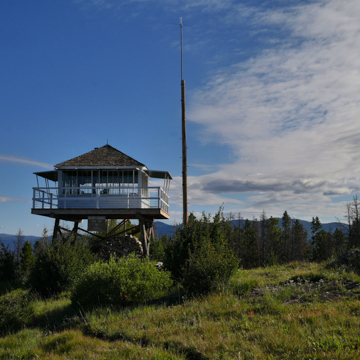In the deeply wooded mountains of the American West, fire is part of the natural balance of life, thinning mature tree stands and rejuvenating the health of the forests. Managing wildland fire has been a primary mission of the U.S. Forest Service since its inception. Gifford Pinchot, the agency’s first director, wrote in 1907 that Congress had created the National Forests “because the forests of the great mountain ranges in the West were being destroyed very rapidly by fire and reckless cutting.” Pinchot recognized that without protection, the nation’s forests—and their timber resources—would be “badly crippled.”
Out on the ground, early rangers had a long list of chores—patrolling against “timber thieves, fraudulent miners, poachers, squatters, and game violators,” building trails and, most importantly, defending the forests against fire. Spotting fires and taking swift action to contain and extinguish the flames was one of the primary responsibilities of U.S. Forest Service employees. And a network of fire lookouts, built on prominent mountaintops throughout the forests of the West, served as the foundation to the nation’s fire suppression program for over 100 years.
The first fire lookouts included small mountaintop log cabins or tree platforms with a view of surrounding lands. The first known lookout built by the U.S. Forest Service was completed in 1909 in Montana’s Cabinet National Forest. The following year, fires swept through Montana and Idaho, challenging a force of 3,000 firefighters to keep up with ninety large fires and more than 3,000 small burns in the summer of 1910. The final blowup in late August tore through the Idaho Panhandle and ripped through much of western Montana, forcing locals to be evacuated on railroad cars and President William Howard Taft to dispatch U.S. Army crews to help on the fireline. When the smoke cleared, the fires had consumed some three million acres, destroying a third of the town of Wallace, Idaho, and claiming the lives of eighty firefighters and additional local residents.
In the aftermath of the “Big Burn,” the agency redoubled its efforts to prevent forest fires, hiring and training thousands of firefighters across the decades, and building thousands of lookouts across the west. A pioneer in the design of fire lookouts was Clyde Fickes, who designed utilitarian, pre-cut buildings that could be carted to the top of a mountain on mules or packhorses and then assembled, “by a couple of handy men who could read” using simple tools like “a hammer, a screwdriver, and level.” The L-4 lookout type was an evolved version, a fourteen-square-foot building in which a fire guard could live and keep watch through windows on all sides that gave a complete 360-degree panorama of the forest. The L-4s came in two styles—first with a gable roof and later, a pyramidal roof—and stood on the ground or atop towers to gain a more commanding view of the surrounding terrain.
The McCart Fire Lookout near Darby, Montana, is a classic L-4 lookout. Assembled on McCart Peak in the Bitterroot National Forest in 1939, it features a pyramidal roof and typical board-and-batten wood awnings that can be lowered to close up the building for winter. A continuous band of large nine-pane windows wraps the wood frame building; beneath the windows the walls are finished with lap siding. A catwalk surrounds the building, which sits on a wooden platform supported by a low tower constructed of peeled log poles with log cross-bracing. The building is painted white and the roof is clad with wood shingles; a lightning rod is perched nearby atop a tall, freestanding log pole.
The lookout stands at an elevation of 7,115 feet and served its original purpose until 1984. After it was taken out of service, the Sula Ranger District restored this lookout in 1991–1992. Complete with its original alidade, simple wooden furnishings, and crank phone, it evokes the life of lookouts who spent months every summer season perched high in the Bitterroot Mountains, on alert for signs of smoke and fire. To commemorate this important history, and the effort by the Forest Service to restore this lookout, it was listed in the National Register of Historic Places in 1994. It is now available for overnight rental through the forest’s popular cabin rental program, offering high mountain accommodations and the chance to experience the world from a forest guard’s point of view.














